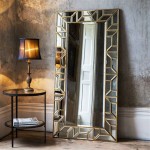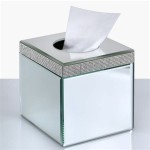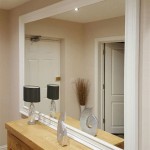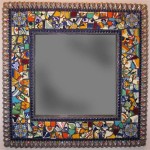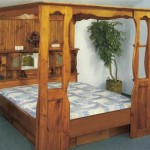Standard Full Length Mirror Dimensions
Choosing the right full-length mirror involves more than just aesthetics. Practical considerations, such as dimensions, play a crucial role in ensuring the mirror serves its intended purpose. This article explores the standard dimensions of full-length mirrors, factors influencing size choices, and the importance of proper placement for optimal functionality.
The most common width for a full-length mirror ranges from 14 inches to 24 inches. Narrower mirrors, around 14 inches, are suitable for smaller spaces or when a quick view is sufficient. Wider mirrors, closer to 24 inches, provide a more comprehensive view of one's outfit and overall appearance. Wider mirrors are often preferred for tasks such as checking posture or practicing presentations.
The standard height for a full-length mirror typically starts at 48 inches and can go up to 72 inches or even taller. A 48-inch mirror might be sufficient for individuals of average height, allowing for a head-to-toe view. However, taller individuals or those desiring a more expansive view may opt for mirrors 60 inches or taller. Mirrors exceeding 72 inches are less common in standard retail settings but can be found through specialized vendors or custom orders.
While the aforementioned dimensions represent common standards, variations exist depending on manufacturer and specific model. Some mirrors are designed with decorative frames that can add to the overall width and height. It is essential to consider the frame dimensions when assessing the mirror's overall size and suitability for a given space.
Several factors influence the ideal full-length mirror dimensions for a specific application. Available space within a room is a primary concern. Measuring the intended location before purchasing ensures the mirror fits comfortably without overwhelming the surrounding area. The mirror's intended use also plays a role. A small, narrow mirror might suffice in a hallway for quick appearance checks, while a larger, wider mirror is more practical in a dressing room or bedroom.
Individual height is another important consideration. The mirror should be tall enough to provide a complete reflection from head to toe for the tallest user. A general rule of thumb is to choose a mirror at least half the height of the tallest person who will be using it. This ensures adequate visibility and avoids the need to stoop or adjust position for a full view.
The mirror's style and design can also impact dimensional choices. Ornate frames or unique shapes might require additional space and consideration. Budget constraints can also influence the selection process, as larger mirrors generally command higher prices. Balancing desired features with available budget and space constraints is crucial for informed decision-making.
Proper placement significantly impacts a full-length mirror's functionality. Natural light is a key factor in achieving accurate reflections. Positioning the mirror near a window or in a well-lit area enhances visibility and provides a more realistic representation of color and appearance. Avoiding placing the mirror directly opposite a window, however, can prevent glare and improve the overall viewing experience.
The surrounding décor and furniture arrangement should also be considered. The mirror should complement the existing aesthetic and not clash with the overall room design. Ensuring adequate clearance around the mirror allows for comfortable use and prevents accidental bumps or damage. Leaving sufficient space in front of the mirror is crucial for individuals to step back and assess their full appearance.
For smaller spaces, leaning full-length mirrors provide a flexible and space-saving alternative to wall-mounted or freestanding options. These mirrors can be easily moved and repositioned as needed, making them ideal for renters or individuals who frequently rearrange their furniture. However, leaning mirrors require a stable surface and should be positioned against a wall to prevent tipping.
Beyond standard rectangular shapes, full-length mirrors are available in various designs, including oval, arched, and even custom shapes. These alternative shapes can add a decorative element to a room while still providing the functionality of a full-length mirror. However, it's important to consider the dimensions of these non-standard shapes carefully, as the usable reflective surface might differ from a traditional rectangular mirror of similar size.
Understanding the standard dimensions of full-length mirrors, along with the factors influencing size and placement choices, empowers informed purchasing decisions. By carefully considering individual needs, available space, and desired aesthetic, individuals can select a full-length mirror that complements their lifestyle and enhances their living space.

Costway 59 In H 22 W Modern Rectangle Frame Gold Features Full Length Mirror Hw66483gd The Home Depot

John Lewis Distressed Full Length Mirror 132 X 52cm Cream

Dressing Mirror Size Dimension Width 23 Inches Depth 14 Height 78 At Rs 13824 In Ratangarh

16 In W X 61 H Full Length Mirror Wall Dressing Hanging Or Leaning Against Bedroom C Xiaso2102 The Home Depot

How To Measure Your Space For A Large Wall Mirror 2 Steps

Full Length Wall Door Hanging Mirror 147x37cm Rectangle Metal Frame Dress

Laser Cut 4u C U In Me Mirrors

Bathroom Mirror Size Calculator

How To Choose The Best Size Mirror Olde Good Things

Bryn Floor Mirror 44x162 Cm Home Centre Saudi

